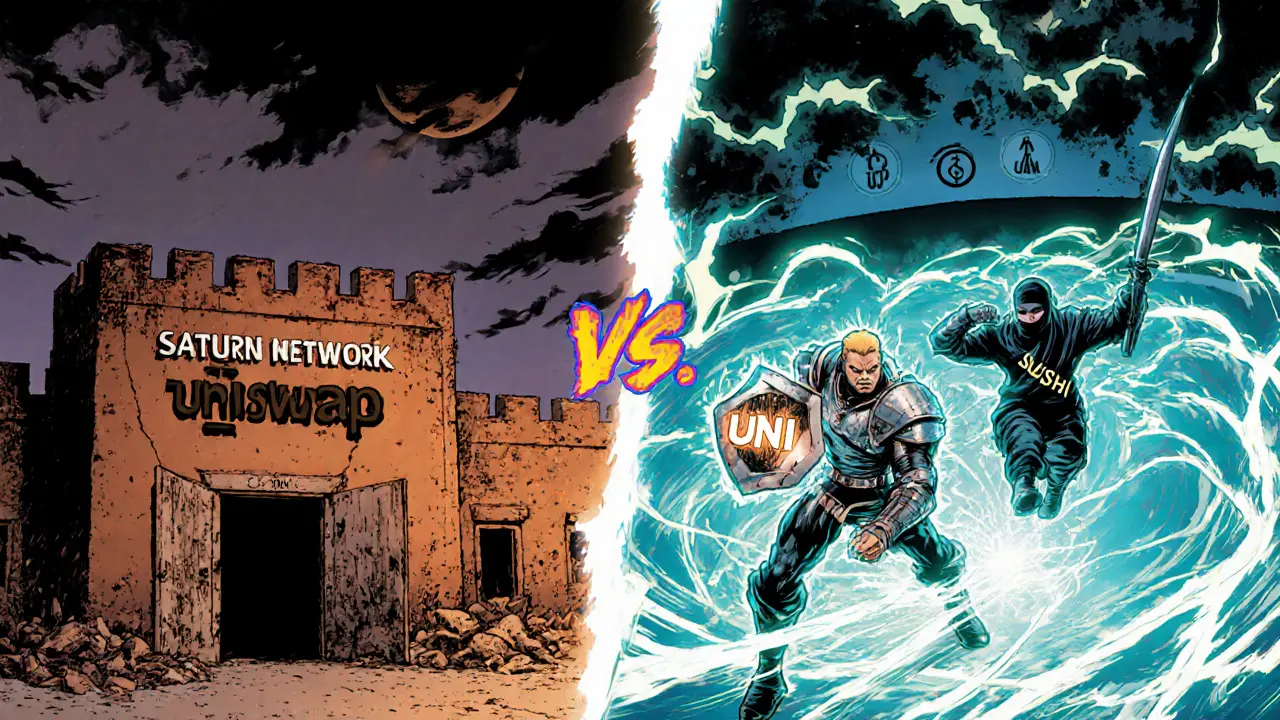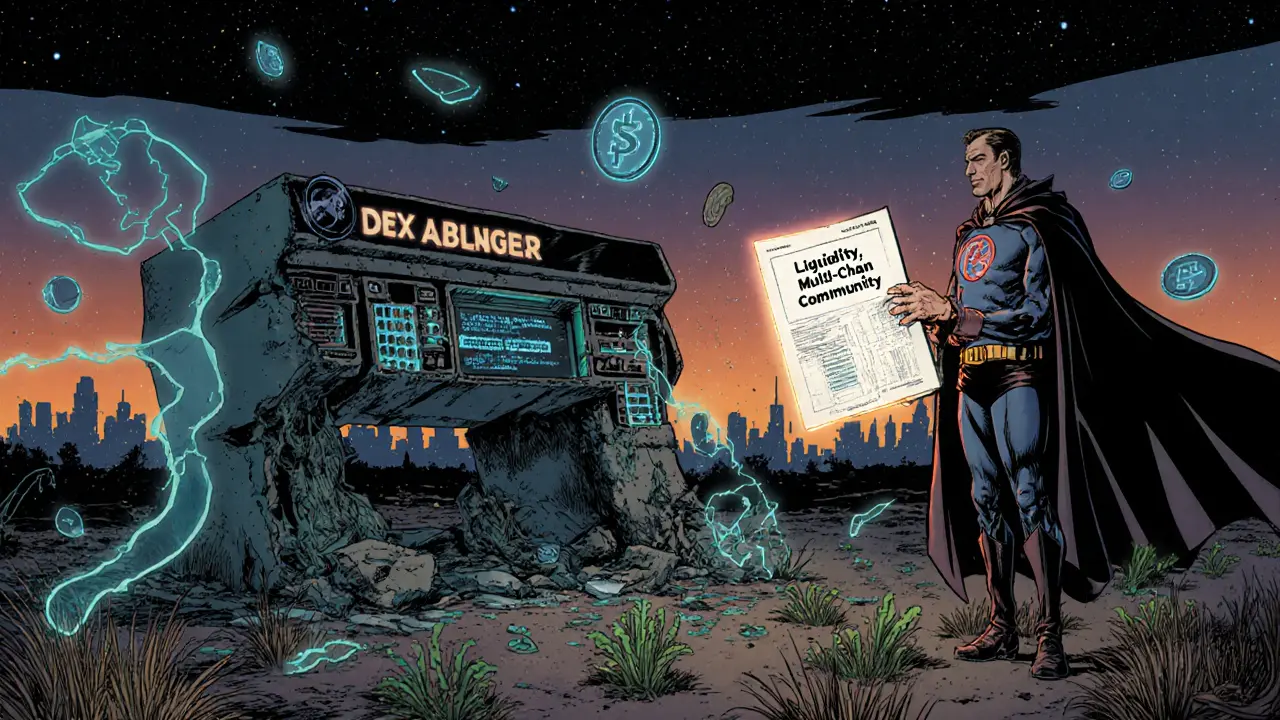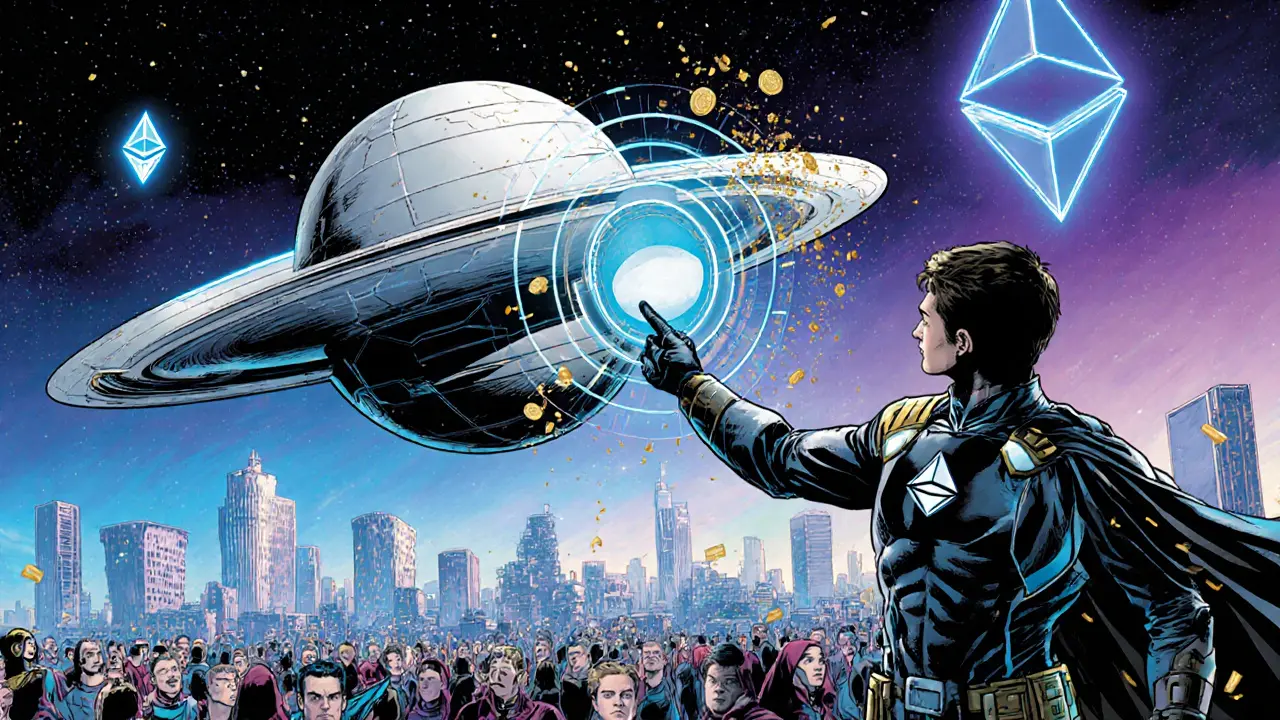Saturn Network DEX Comparison Tool
Saturn Network
- Supported Chains Ethereum, Ethereum Classic
- Liquidity Incentives SATURN token (Never Released)
- Average Daily Volume $0 USD
- Governance Model DAO via SATURN token
- Status Defunct
Uniswap
- Supported Chains Ethereum, Polygon, Optimism, Arbitrum
- Liquidity Incentives UNI token, liquidity mining
- Average Daily Volume ~$12B
- Governance Model DAO via UNI token
- Status Active
SushiSwap
- Supported Chains Ethereum, BSC, Polygon, Avalanche
- Liquidity Incentives SUSHI token, yield farms
- Average Daily Volume ~$2B
- Governance Model DAO via SUSHI token
- Status Active
Key Takeaways
- Liquidity is King: Saturn had none; Uniswap and SushiSwap have billions.
- Multi-chain Support: Saturn was limited to two chains; others support many.
- Community: Saturn lacked engagement; both Uniswap and SushiSwap thrive with strong communities.
- Token Incentives: Saturn's token never launched; active DEXs offer live rewards.
- Execution: Saturn failed to deliver on promises; active DEXs iterate regularly.
Why Saturn Network Failed
Saturn Network struggled due to lack of liquidity, limited chain support, weak community, intense competition, and developer inactivity. These factors combined to render it obsolete in the rapidly evolving DeFi landscape.
Saturn Network is a now-defunct open‑source decentralized exchange (DEX) that once aimed to enable peer‑to‑peer token trading on the Ethereum and Ethereum Classic blockchains. The platform relied on smart contracts to execute trades without custodial wallets and used the SATURN token as a governance instrument for its DAO. Below is a quick snapshot of what the project was, why it failed, and how it stacks up against active DEXs today.
Quick Takeaways
- Saturn Network launched as a non‑custodial DEX on Ethereum and Ethereum Classic.
- It offered liquidity rewards paid in SATURN, but never reached critical mass.
- Major tracking sites now list the exchange as defunct with zero trading volume.
- Competing DEXs like Uniswap and SushiSwap dominate with billions in daily volume.
- Investors included CMS Holdings, Big Brain Holdings, Sora Ventures, UTXO Management, and BOOGLE.
What Saturn Network Tried to Build
The core promise was simple: let users trade ERC‑20 tokens without ever handing over private keys. By leveraging Ethereum the world’s leading smart‑contract platform and Ethereum Classic a fork of Ethereum with a focus on immutability, the protocol could execute trades directly on‑chain. The architecture resembled other DEXs - orders were hashed into contracts, matched off‑chain, and settled on‑chain. The decentralized exchange model removes a central custodian, reducing hack risk.
Liquidity incentives were built into the protocol. Market makers who filled orders earned SATURN tokens, which also gave holders voting rights in the DAO a decentralized autonomous organization that governs protocol upgrades. The tokenomics planned a 1billion supply, but tracking sites now show both total and circulating supply at zero, indicating the token never really launched.
Why It Didn’t Take Off
Several factors converged to push Saturn Network into the graveyard:
- Lack of liquidity. Without deep order books, users faced high slippage and could not execute large trades.
- Limited chain support. Focusing only on Ethereum and Ethereum Classic left out fast‑growing ecosystems like Binance Smart Chain, Polygon, and Avalanche.
- Weak community. The platform never built a vibrant forum, Discord, or Telegram presence, so there was no viral user growth.
- Competition. Established DEXs such as Uniswap, SushiSwap, and PancakeSwap already offered better UI, lower fees, and massive liquidity pools.
- Developer inertia. After the initial funding round-backed by CMS Holdings, Big Brain Holdings, Sora Ventures, UTXO Management, and BOOGLE-the team seemed to lose momentum, with no new releases reported after 2022.
Consequently, tracking platforms like CryptoWisser label Saturn Network as “dead”, and CoinMarketCap lists it as an “Untracked Listing” with no volume data.

How It Compares to Active DEXs
| Feature | Saturn Network | Uniswap | SushiSwap |
|---|---|---|---|
| Supported Chains | Ethereum, Ethereum Classic | Ethereum, Polygon, Optimism, Arbitrum | Ethereum, BSC, Polygon, Avalanche |
| Liquidity Incentives | SATURN token (never released) | UNI token, various liquidity mining programs | SUSHI token, yield farms |
| Average Daily Volume (2025) | 0USD | ~$12B | ~$2B |
| Governance Model | DAO via SATURN token | DAO via UNI token | DAO via SUSHI token |
| Current Status | Defunct / No trading | Active | Active |
The table makes it clear why traders abandoned Saturn Network: zero volume, limited chain reach, and an unfinished token incentive program.
Investor Backing and Funding
Even with institutional support, money alone couldn’t save the project. The round included:
- CMS Holdings - Tier2 venture capital.
- Big Brain Holdings - Lead investor, Tier3.
- Sora Ventures - Tier4 lead.
- UTXO Management - Tier4 venture capital.
- BOOGLE - Corporate investor, Tier4.
None of these firms have publicly announced follow‑on funding, which suggests the team failed to hit milestones that would trigger additional capital.
Lessons for Future DEX Builders
If you’re considering launching a new DEX, Saturn Network’s story offers a checklist:
- Liquidity is king. Secure enough market makers early, perhaps via a launch‑pad or partnership.
- Multi‑chain support. Users gravitate toward platforms that let them trade on fast, cheap layers.
- Active community management. Continuous engagement through social channels drives network effects.
- Clear tokenomics. Reward structures must be live, transparent, and sustainable.
- Iterative development. Regular upgrades keep the protocol competitive against fast‑moving rivals.
Current Status and Future Outlook
As of October2025, there is no sign of revival. The website is offline, the smart contracts are still on‑chain but inactive, and no developer has posted updates. The SATURN token never entered circulation, so holders (if any) cannot participate in governance.
For investors, the lesson is to scrutinize not only the amount of capital a project raises but also the roadmap execution, community health, and real‑world liquidity metrics.

Frequently Asked Questions
Is Saturn Network still usable?
No. The exchange’s web interface is offline, and the smart contracts have no active order‑matching logic. All trading pairs show zero volume.
What happened to the SATURN token?
The token never launched on major exchanges. Tracking sites list both total and circulating supply as zero, indicating it was never minted or distributed.
How does a non‑custodial DEX keep funds safe?
Users retain private keys in their wallets; trades are settled by smart contracts. Even if the platform’s servers are compromised, the funds remain in users’ wallets.
Can I earn rewards on Saturn Network today?
No. The liquidity mining program required the SATURN token, which never became tradeable. There are no active reward contracts.
What are better alternatives for Ethereum‑based DEX trading?
Uniswap V4 and SushiSwap are the market leaders, offering deep liquidity, multi‑chain bridges, and active governance communities.


Vaishnavi Singh
April 16, 2025 AT 17:02It's striking how many DeFi projects forget the basic principle that liquidity begets utility. When a platform launches without a clear path to attract market makers, it merely builds a hollow shell. Saturn's ambition was noble, yet the execution lacked the scaffolding needed for a thriving ecosystem. The absence of a token distribution also signaled a missing incentive layer. In hindsight, the project serves as a quiet reminder that vision alone cannot sustain a DEX.
Peter Johansson
April 20, 2025 AT 18:15Great read! 👍 The comparison really highlights why community incentives matter so much. Seeing Uniswap's $12B daily volume next to Saturn's $0 makes the gap obvious. If you’re looking to jump into DeFi, sticking with the platforms that actually reward liquidity is the safest bet. 🚀 Keep sharing these deep dives!
Gaurav Gautam
April 24, 2025 AT 16:42I see a pattern here: projects that double‑down on multi‑chain support tend to survive longer. Saturn limited itself to Ethereum and its classic fork, while competitors spread across Polygon, Arbitrum, and even BSC. That limitation not only raised fees for users but also throttled potential liquidity inflows. By ignoring the fast‑lane chains, they essentially cut off a major growth channel.
victor white
April 28, 2025 AT 12:22One cannot dismiss the subtle machinations that hover behind defunct protocols. Saturn's silence may be less about mere mismanagement and more about orchestrated suppression by larger AMMs guarding their hegemony. The undisclosed token, never minted, whispers of a deliberate stifling of a rival's governance ambitions. Moreover, the abrupt disappearance of developer updates hints at a coordinated hijack of the project's momentum. In the grand chessboard of DeFi, such quiet removals are not unprecedented.
mark gray
May 2, 2025 AT 05:15That’s an interesting take. While the market is competitive, many projects simply run out of steam without any grand conspiracy.
Alie Thompson
May 5, 2025 AT 19:22It is incumbent upon every participant in the decentralized finance arena to uphold the highest standards of responsibility, for the very fabric of trust that underpins our digital economies is woven from the threads of collective integrity. When a venture such as Saturn Network emerges with grand proclamations yet fails to deliver tangible value, it not only squanders investor capital but also erodes confidence in the broader ecosystem. The absence of a functional token, an essential mechanism for incentivizing liquidity, serves as a glaring indictment of poor governance and misguided priorities. Liquidity, the lifeblood of any exchange, was conspicuously absent, leaving traders exposed to crippling slippage and abandonment. Moreover, the decision to restrict operations to merely two blockchains disregarded the evolutionary trajectory of scalability and cost‑efficiency that newer layers provide. Communities thrive on engagement, dialogue, and transparent roadmaps; Saturn's silence in forums and social channels speaks volumes about its disregard for stakeholder inclusion. By neglecting to cultivate a vibrant community, the project alienated potential contributors and missed out on the network effects that fuel organic growth. The reliance on a single token that never entered circulation reflects a fundamental failure to align incentives with participant behavior. Without active reward structures, market makers are left unmotivated, and the exchange's order books remain barren. The competitive landscape, populated by platforms that iterate rapidly and adapt to user feedback, left little room for stagnation. In this context, Saturn's inertia appears not merely as a misstep but as a cautionary exemplar of what transpires when ambition outpaces execution. Ethical stewardship demands that founders and developers deliver on promises, maintain open communication, and prioritize sustainable tokenomics. Failure to do so not only jeopardizes a singular project but also casts a shadow over the credibility of decentralized initiatives at large. Consequently, the demise of Saturn Network should be studied, analyzed, and internalized as a moral lesson for future builders. Only by learning from such oversights can the DeFi community aspire toward a more resilient and trustworthy future.
Samuel Wilson
May 9, 2025 AT 06:42Thank you for that comprehensive reflection. Your emphasis on accountability and transparent tokenomics resonates deeply with best practices. Maintaining open lines of communication is indeed essential for sustained trust.
Rae Harris
May 12, 2025 AT 15:15Honestly, the whole “Saturn failed because of liquidity” narrative feels a bit too textbook. Sure, volume matters, but the real blocker was probably the lack of a robust AMM curve and adaptive fee model. If they’d implemented a dynamic fee scheduler, even thin pools could've been viable. Plus, the tokenomics could've been restructured on‑chain to auto‑mint rewards, sidestepping the whole launch fiasco.
Rebecca Stowe
May 15, 2025 AT 21:02That’s a fresh perspective! Even small tweaks can sometimes turn the tide for a project.
mannu kumar rajpoot
May 19, 2025 AT 00:02Let’s cut through the hype: Saturn was a textbook example of a vanity project with empty promises. The so‑called “decentralized governance” never materialized, and the token never existed, which screams a coordinated cover‑up. If you dig deeper, you’ll see patterns of funding disappearing into shell entities.
Tilly Fluf
May 22, 2025 AT 00:15I appreciate your candor, though I would caution against jumping to conclusions without verifiable evidence. Nonetheless, the experience underscores the importance of transparent funding trails.
Darren R.
May 24, 2025 AT 21:42Ah, the tragedy!; A saga of ambition unmoored from reality; A cautionary tale for all who dare to dream in code; Yet, let us not forget the noble intent that sparked the venture; Even in collapse, there lies a lesson; That the road to innovation is paved with both triumphs and bruises; Embrace the fallout, learn, rebuild!
Hardik Kanzariya
May 27, 2025 AT 16:22DeFi moves fast; stay adaptable.